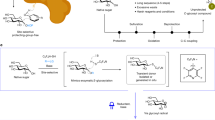Play all audios:

ABSTRACT THE issue of NATURE of July 9, p. 44, contains a communication by Prof. R. Robinson, in which, on purely speculative grounds, far-reaching conclusions are drawn (1) regarding the
origin in Nature of galactose, and (2) regarding the configuration of the pentose of the plant nucleic acid. The second conclusion met with the approval of Haworth. Access through your
institution Buy or subscribe This is a preview of subscription content, access via your institution ACCESS OPTIONS Access through your institution Subscribe to this journal Receive 51 print
issues and online access $199.00 per year only $3.90 per issue Learn more Buy this article * Purchase on SpringerLink * Instant access to full article PDF Buy now Prices may be subject to
local taxes which are calculated during checkout ADDITIONAL ACCESS OPTIONS: * Log in * Learn about institutional subscriptions * Read our FAQs * Contact customer support SIMILAR CONTENT
BEING VIEWED BY OTHERS DIRECT RADICAL FUNCTIONALIZATION OF NATIVE SUGARS Article Open access 19 June 2024 SOURCE FILES OF THE CARBOHYDRATE STRUCTURE DATABASE: THE WAY TO SOPHISTICATED
ANALYSIS OF NATURAL GLYCANS Article Open access 30 March 2022 AN ALTERNATIVE BROAD-SPECIFICITY PATHWAY FOR GLYCAN BREAKDOWN IN BACTERIA Article 19 June 2024 AUTHOR INFORMATION AUTHORS AND
AFFILIATIONS * The Rockefeller Institute for Medical Research, New York P. A. LEVENE Authors * P. A. LEVENE View author publications You can also search for this author inPubMed Google
Scholar RIGHTS AND PERMISSIONS Reprints and permissions ABOUT THIS ARTICLE CITE THIS ARTICLE LEVENE, P. An Aspect of the Biochemistry of Sugars. _Nature_ 120, 621 (1927).
https://doi.org/10.1038/120621b0 Download citation * Issue Date: 29 October 1927 * DOI: https://doi.org/10.1038/120621b0 SHARE THIS ARTICLE Anyone you share the following link with will be
able to read this content: Get shareable link Sorry, a shareable link is not currently available for this article. Copy to clipboard Provided by the Springer Nature SharedIt content-sharing
initiative
